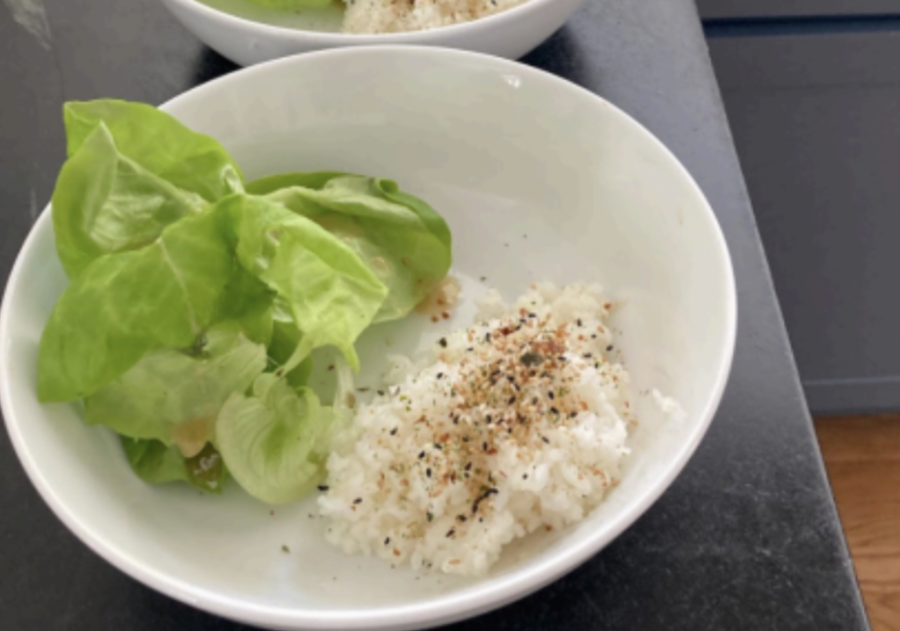Simple dish makes perfect lunch
February 9, 2022
There is something incredibly wholesome about this simple dish. Its ingredients come from humble origins, yet the combination of bright flavors feels remarkably satisfying. This dish pairs perfectly-cooked Japanese short- grain rice with buttery lettuce. The lightest of miso vinaigrettes provides a refreshing zing to the salad, adding an acidity that cuts through the richness of the lettuce and complements the sweetness of the rice. This meal is nourishing and perhaps best enjoyed as a light lunch with family or friends. It is an absolute favorite of mine.
I did not plan this dish in advance but was desperate for a quick, early lunch, so I simply used what I had in my kitchen. Because producing a filling meal was my primary goal, I made the star ingredient a starch. While I am a firm believer that good cooking is a result of proper technique—an aspect of the culinary arts that is severely undervalued in the United States—it is also important for a cook to trust their instincts when building flavors. Good eaters usually make good cooks because they understand what flavors pair. A good cook is not ambitious when they design a new dish. They use what they know. Their food makes sense.
When designing a new dish, I adhere to the notion that if it has not been done before, there is a reason for it. Instead of pairing random flavors with each other I prefer to adopt flavor combinations that I have enjoyed in the past, and through technique, apply them in different ways. For this dish in particular, the pairing of rice, bright, fresh lettuce and a miso vinaigrette is an ode to the poke bowl.
Often, the fewer ingredients in a dish, the harder it is to get it right. While this dish is not particularly complex—there are no decadent sauces or luxury ingredients involved—there is nowhere for mistakes to hide. For the best possible results, the dish must be executed with a degree of knowledge, precision, and proper technique.
Preparation of the rice: Japanese short-grain rice absorbs a good deal of water, so the correct rice-to-water ratio is about 1.1 cups of water for every cup of rice. In addition, it is absolutely essential that one washes the rice before cooking in order to remove the starch coating from each grain—otherwise the final product will take on the consistency of plaster. Once cooked, you should be able to taste and feel every individual grain of rice. It should still be a little sticky such that it holds together but far from wet.
Cooking the rice: The best way to cook Japanese short-grain rice is in a rice cooker. While I don’t want to say cooking this type of rice for our purposes on the stove is wrong, it’s wrong. Regulating heat is essential when cooking rice. In a rice cooker, once the water reaches a boil, the heat will automatically drop to a simmer (about 190o F) until the water is absorbed. The temperatures are consistent, and the rice will come out correctly every time. If you don’t have one, buy one.
The vinaigrette: The last technical component in creating this dish is the vinaigrette. According to French tradition, a vinaigrette has an acid-to-oil ratio of 3:1. A variety of stabilizers can be used, including mustard, egg yolks, or honey. Here, we use miso. Because miso is the only stabilizer in this vinaigrette, it can be narder to emulsify and easy to split. As a result, be careful to add in the oil very slowly, and don’t panic. You can often bring it together by whisling vigorously for about five minutes or mixing the vinaigrette in a blender for about 15 seconds.
Seasoning: Furikake is a seasoning used in some Japanese military beginning in World War I as a means to fight malnutrition. It is primarily a mixture of dried fish flakes (usually from Bonito), sesame seeds, and dried seaweed. Furikake has increased in popularity in the United States, and it can be found at most supermarkets. It is the ultimate umami explosion.
Recipe:
3 tbsp grape seed oil
1 tbsp + 1 tsp white miso
1 tbsp white wine vinegar or rice vinegar
1 head bibb lettuce
1 1⁄2 cups Japanese short-grain rice
A tad under 1 3⁄4 cups water
White sesame (to taste)
Furikake (to taste)
Instructions:
1) In a large bowl, wash rice in cold water until the water runs clean (about three times). Use a small colander to strain and remove water for each cycle.
2) Add rice and water into your rice cooker (a pot if you don’t have a rice cooker) such that there is a rice-to-water ratio of 1:1.1
3) While your rice cooks, prepare the salad. Cut off the root of the bibb lettuce and carefully wash each leaf and dry with a paper towel.
4) Combine the miso and vinegar in a small bowl.
5) Slowly add in the oil in a gentle stream and whisk vigorously so as not to break the vinaigrette. Add no more than 1 tsp of oil at a time while whisking.
6) When the rice is finished cooking, begin to plate. Place a generous spoonful of rice in a bowl, and place the bibb lettuce to its side. Drizzle a small amount of miso vinaigrette over your salad. Refrigerate the remaining vinaigrette for up to two weeks.

